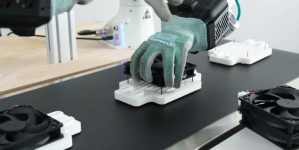-
AI startup Onton raises $7.5M to reinvent the way the world discovers and decides what to buy - November 26, 2025
-
Forklift Market Positions for Recovery as Confidence Expected to Build from 2026 - November 26, 2025
-
PROCare achieves 300% order capacity increase and 99% picking accuracy with Forterro’s ERP solution, Orderwise - November 26, 2025
-
DHL boosts operational efficiency and customer communications with HappyRobot’s AI Agents - November 25, 2025
-
STENA LINE TEAMS UP WITH CAMERA TELEMATICS TO DRIVE SAFETY IMPROVEMENTS AT IRISH SEA PORTS - November 25, 2025
-
Another design award for Toyota’s lithium-ion Traigo_i counterbalanced forklift - November 21, 2025
-
Stuut Technologies Raises $29.5 Million Series A Led by Andreessen Horowitz to Automate Accounts Receivable Work - November 20, 2025
-
INCREASED DIGITAL INVESTMENT REQUIRED TO KEEP PACE WITH 2026 CUSTOMS CHANGES - November 19, 2025
-
FULFILMENT SOLUTIONS FOR SPORTS MERCHANDISE: KEEPING OUR EYE ON THE GAME - November 19, 2025
-
COMPLEX, COSTLY & CONFUSING – THE END OF DE MINIMIS - November 19, 2025
The Impetus for Change.
By Andrea Belk Olson, MSC and CEO of Pragmadik
Andrea writes original articles across a spectrum of topics, providing unique insights to leadership, technology, marketing, business development, and communications.
https://www.linkedin.com/in/olsonandrea1/
We talk about change at length. There are thousands of books on change, change management, and leadership, all centered on creating and facilitating change. Often times, we know change needs to happen. Or we long for things to be “better” or “different”. Yet, with rounds of attempts, organizations and individuals still struggle with creating lasting change.
Why is this the case? Does the issue lie with the idea? The approach? The people? We blame these factors often, but the core problem with creating and implementing change is learning process. And learning takes persistence and time.
We talk about learning, because companies are asking more and more for “soft skills” from their employees and prospective hires. Problem solving, public speaking, logic, analysis skills, empathy, and more. In response, higher education institutions are responding by providing courses, certificates and degrees in specialized areas including data analytics.
Yet, even with these skills in hand, still organizations struggle. Individually, we each have a tendency toward either our left-brain (analytical thought, logic, science) or our right-brain (holistic thought, intuition, creativity). But leading change has as much to do with right-brain functions, particularly holistic thought (seeing systems as a whole) andcreativity. And being effective in creating change depends on the effective combination of the two.
I joined the ranks of corporate management after an extensive, almost 10-year stint at a small tech startup company. I entered an organization that knew the book on business. They applied every b-school framework to a problem, without giving enough consideration to whether any of it actually applies to what we were trying to accomplish, and how it impacts those that are involved in the change.
I approached one of my key staff members that was struggling with developing and implementing a change we needed to make in the department. We had a long discussion about context and the relative value of frameworks and models (“hard” knowledge) vs. specific contexts (“soft” knowledge). I talked a lot about the value of discussion and debate – he was very process-oriented, and felt as though he had “checked all the necessary boxes” but was still struggling to gain support. I emphasized the need to ask questions in order to learn, help others understand what we are doing and why, and convinced him – quickly – that implementing change was an experiential learning process for him and those involved.
Many people view asking questions as some sort of sign of weakness. Shouldn’t a leader have all the answers? Actually, no. We derive the competence to succeed by constantly asking “big picture” questions rather than just applying a rigid formula. Yes, we need to know certain things before we talk to a potential client or teammate, but we also need to know that we don’t know it all. Asking questions help you gain insight and perspective to the small things that can stop forward progress. Some critical questions to ask can include:
What are the factors that need to change? Are they strategic, operational, cultural or all three?
What is really happening in the environment we are addressing? What are our other organizations up to? What is the worst thing that could happen if we tried an idea and failed?
What are our priorities? What do our other leaders and my team/peers think we should be doing? Are those the same or is there a disconnect?
Who are the people, inside and outside the company, that are key for making a change successful?
The questions are generally the same – it’s the context that changes. Change is a learning process and certainly not a formula learned in school or found in a book.

































